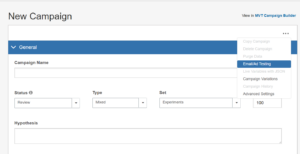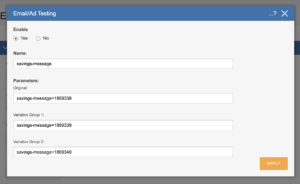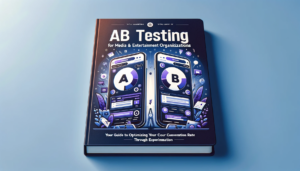Favorite Feature: Email and Ad Testing
By Ruby Brown
April 17, 2020
Share
SiteSpect’s Customer Services team know the tool better than anyone. From building campaigns to advising on optimization strategy they use every feature SiteSpect has to offer. In this blog, Kate Orchard, Senior Optimization Consultant at SiteSpect, shares her favorite feature.
Favorite Feature
Email / Ad Testing, located in the three dot menu within the A/B Builder.

How Does It Work?
Once you have your different experiences built out, you can enable email/ad testing on your campaign. A URL parameter will be generated for each variation group, which you include on the corresponding links from your emails or ad placements. You can choose a name for the parameter, and the value will be generated based on the variation group ID.

When a user clicks through from one of the links, they will be automatically assigned to the corresponding variation group.
What Are the Benefits, and When Would Someone Use This Feature?
You can test different end-to-end experiences and ensure users see the same experience throughout. Without this feature you would have to create a separate campaign for each email or ad version, at which point the analytics would be split out over multiple campaigns, making it difficult to compare each version against the others.
Why Is It Your Favorite Feature?
Email / Ad Tracking is my favorite feature for a few reasons.
Marketing initiatives and site optimization efforts are not always coordinated. So, often marketing efforts go only as far as a landing page, if that. The marketing channel gets the user to the site with appealing messaging, offers, and visuals, but once the user starts navigating around, all of that is lost.
They’re helping feed the top of the funnel, but the continuity is lost for the rest of the journey.
Plus, while marketers are very interested in open and click rates, they ultimately want to learn which campaign resulted in the highest conversion. For example, one version of ad copy might get more users to click through, but if it doesn’t align with the personality on the website, those users might not convert. Another version of the copy might have lower click-through rates, but because it’s more aligned with the site overall, users are more likely to convert. But also, how great would it be to pull in that same personality from the ad into the site itself? Maybe you can get the best of both worlds.
With this feature you can track and optimize the full experience.
Additionally, if the marketing message was for a specific offer, the user might forget the details of that offer and leave the site because they can’t remember the promo code, or they think the offer is no longer available, or they’re just trying to track down the original details and never return. This feature also maintains that consistency for each user.
What’s an Example of How You’ve Used Email / Ad Tracking in the Past?
We had a clothing client use this to test different photoshoot scenes on Instagram. They had a city shoot, a nature shoot, and a studio shoot. They could show different scenes within Instagram, and then use the campaign to ensure the users coming in saw the same images across the entire site, they applied this on landing pages, category pages, and product listing pages.
Share
Suggested Posts
Subscribe to our blog:





